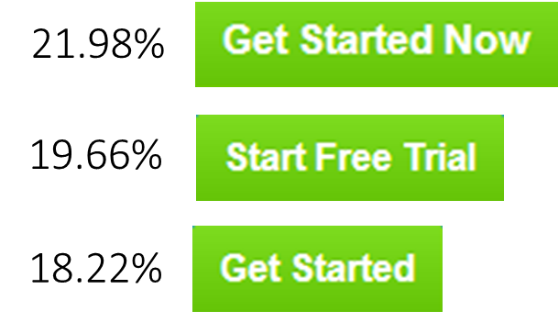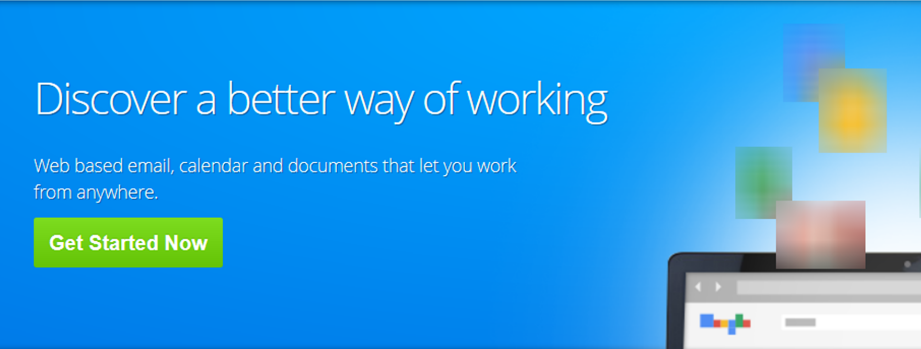Earlier this year, a team of analysts approached me about a closed case that was reopened for additional interpretation. It was about button copy, and the results were initially baffling.
Here are three of the prominent treatments and their respective clickthrough rates, each with a statistically significant difference in comparison:
Does this look familiar? While Daniel Burstein did a great job covering the “what” of this test earlier this year in this MarketingExperiments Blog post, he did not have opportunity to go into the why:
- Why didn’t “Start Free Trial” win?
- Isn’t there more value by highlighting the word “Free?”
- Why is it that the word “Now” in “Get Started” was the difference between underperforming or outperforming “Start Free Trial?”
Everyone in digital marketing is convinced that a call-to-action is a button or a link — something that people can click, or touch, and it will take them off the current view and into another. Because of this preconception, they often create and improve their calls-to-action with the same kind of tunneled focus.
Unfortunately, that’s not how the customer looks at it.
To the customer, the clickable thing has no meaning outside of its surrounding context
Take this classic example of context from Leonard Mlodinow’s book Subliminal.
Read this sentence:
“The cooking teacher said the children made good snacks.”
Now read this one:
“The cannibal said the children made good snacks.”
The meaning of the word “made” has significantly changed hasn’t it? In fact, the meaning of that one word is dependant on the context in which it is placed.1
Now, let’s take another look at those green buttons in their surrounding context by reading all of the text before:
Versus
Can you feel the difference? (notice I said feel, not see)
“Start Free Trial” implies a potential future cost when compared to “Get Started Now”
In fact, “Get Started” without the “Now” can also imply a potential future cost. At least with the trial there is some duration of “Free.” However, even the power of the word “free” on our unconscious could not mask the fact that it is still a trial.
The key to finding those subtle changes that produce significant gains is to understand the context that powers them.
Why?
Because to the customer, the call-to-action is not limited to just a button or a link. To the customer, the call-to-action encompasses every element on a page that moves the immediate conversation into an immediate next step.
One of our readers, Viktor, left a comment on Daniel’s previous article that summed up the finding fairly well:
“So maybe it’s not the CTA alone that increases click-through, but a combination of a headline and a correct CTA to allow user to act on that headlines value.”
This is what led us to conduct a thorough meta-analysis on what I call a true call-to-action variable cluster in the eyes of the customer.
What we discovered when looking in the database with this new perspective was fascinating. What once was a limited area of focus (and results, frankly) has now expanded to a larger set of possiblities.
What’s the immediate takeaway? The advanced marketer goes beyond the button and goes into the full context of the transition in the conversation.
We are not optimizing web pages. We are optimizing thought sequences.
1 Mlodinow, Leonard. Subliminal: How Your Unconscious Mind Rules Your Behavior. New York: Pantheon Books, 2012Editor’s Note: Interested in meeting one-on-one with Jon to discuss email and acquisition? Join him and our research team at DMA 2014 to explore crafting email messages that convert and overcoming three of the most common mistakes marketers make with their calls-to-action.
You might also like
Email Design How-to: 5 insights to improve open and clickthrough rates [MarketingSherpa how-to article]
Landing Page Optimization: Radical redesign leads to 3,566% increase in conversion [MarketingSherpa case study]
Marketing Research Chart: Does A/B testing deliver a positive ROI? [MarketingSherpa chart]
Landing Page Optimization: 5 factors that lead to (and prevent) conversion[More from the blogs]







Great post on the Why of that specific case Jon. I completely forgot I commented on that previous post 🙂
Optimizing thought sequences…that’s really something to think about when determining the best call to action. Thanks!